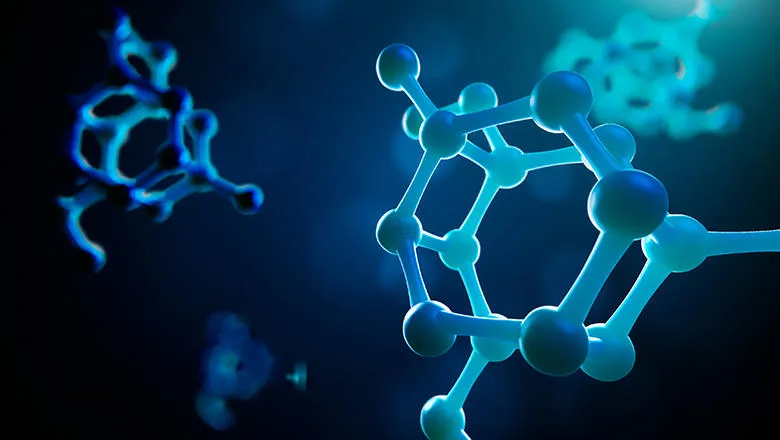PySoftK will allow us to accelerate the development of novel polymers for a whole range of applications, from using polymers with embedded nanoparticles to stitch human tissue together, to improving energy storage methods. These materials will help form a building block to tackle large scale challenges that we face in health care, in developing biodegradable home and personal care products and in creating more environmentally friendly energy storage systems”.
Professor Chris Lorenz, Department of Physics
12 May 2023
Researchers develop advanced software to speed up discovery of new polymers
The software facilitates the use of computer simulations at a complex molecular scale to design new polymer materials

A programme to advance the discovery of new polymers has been developed by a team of interdisciplinary researchers across King’s Faculty of Natural, Mathematical and Engineering Sciences. The software called PySoftK uses AI to identify new polymer materials, which could be used across a wide range of applications including in medical technology, pharmaceuticals, energy storage and more.
Professor Chris Lorenz from the Department of Physics and lead researcher on the technology said:
Polymers are large molecules made up of smaller repeating molecules called monomers, which bond together in a chain-like fashion to form a long polymer molecule. Polymers can be naturally occurring, such as proteins and DNA, or they can be synthetic, such as plastics and synthetic fibres. This new software development could change the way we investigate the relationship between the chemical structure and function of new polymeric materials, by providing a robust dataset for researchers to train artificial intelligence (AI) to identify desirable polymer properties.
Synthetic polymers can be designed to interact with changes in their environment or make use of certain properties. For example, Gore-Tex, a polymer used in clothing was developed as an improvement to nylon, a traditional polymer. While both materials are waterproof, Gore-Tex is also be breathable, because it has been designed with a particular chemical property to perform a specific function. This is known as a designer polymer.
Other areas where designer polymers are used, include medical ointments, paints, coatings, food packaging, biomedical imaging and energy storage. Designer polymers have the potential to have a wide range of different functions due to their underlying physical and chemical properties, which originate from the type and arrangement of monomers which build the polymer.
To advance our discovery of these types of materials, high-performance computers (HPCs) are used to simulate and predict the behaviour of polymers, which then informs researchers how best to build polymers with the desired properties for fulfilling certain tasks.
Over the past several decades, molecular scale simulations, computer simulations representing 3D structures of molecules, have improved our understanding of the relationship between chemical structure and function in increasingly complex polymers. However, more recent advances in computing power and computational algorithms have enabled scientists to investigate more complex systems and provide more accurate predictions using molecular-scale simulations at speed. This can lead to faster and more cost-effective design of materials, as less time is devoted to rounds of experimentation.
Professor Chris Lorenz suggests:
“Normally, maintaining a large, diverse and accurate molecular database can be a hugely costly and time intensive process, as researchers race to label and categorise models correctly.
By offering a set of tools and programming modules to automate the process of curating, modelling and creating libraries of polymers, PySoftK facilitates the generation of large databases on which to train future machine learning (ML) and deep learning (DL) models. This allows researchers to move their focus away from exhaustive library maintenance and onto discovering new materials.”
Dr Alejandro Santana Bonilla, Research Software Engineer within the Faculty of Natural, Mathematical and Engineering Sciences, and one of the lead researchers on the project said,
“The software package is versatile, flexible, and easy to install. It can generate a wide range of polymer topologies and perform library generation in a fully parallelised manner, making it highly efficient,”
Researchers hope that these models will be the driving force of new designer polymer development. PySoftK could also play a significant role for researchers in nano- and bio-technology, who are searching for new functional materials. But without reliable data to train the AI, they risk making inaccurate predictions.
Ultimately, the integration of molecular scale simulations and machine learning into the rational design process for designer polymers will be vital to furthering our understanding between the chemical structure and function of complex materials”
Professor Chris Lorenz, Department of Physics
The team of researchers developing PySoftK are led by Alejandro Santana Bonilla, Research Software Engineer and Chris Lorenz, a Professor in the Department of Physics. With significant contributions of Peike Sun, a Physics undergraduate student, Raquel Lopez-Rios De Castro, a London Interdisciplinary Doctoral Programme PhD student, and Robert M Ziolek, a postdoc in the Department of Physics. They have recently written a paper summarising the current features of PySoftK, which can be found here.

